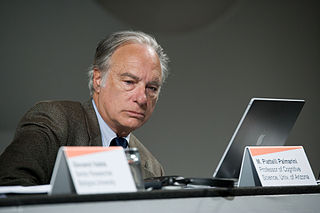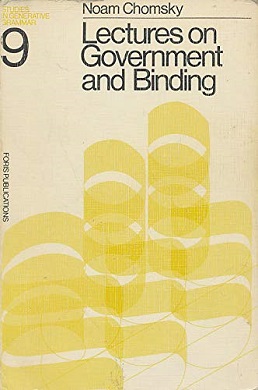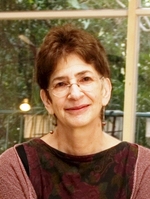Related Research Articles

In linguistics, syntax is the study of how words and morphemes combine to form larger units such as phrases and sentences. Central concerns of syntax include word order, grammatical relations, hierarchical sentence structure (constituency), agreement, the nature of crosslinguistic variation, and the relationship between form and meaning (semantics). There are numerous approaches to syntax that differ in their central assumptions and goals.
Lexical semantics, as a subfield of linguistic semantics, is the study of word meanings. It includes the study of how words structure their meaning, how they act in grammar and compositionality, and the relationships between the distinct senses and uses of a word.
Deep structure and surface structure are concepts used in linguistics, specifically in the study of syntax in the Chomskyan tradition of transformational generative grammar.

Generative grammar, or generativism, is a linguistic theory that regards linguistics as the study of a hypothesised innate grammatical structure. It is a biological or biologistic modification of earlier structuralist theories of linguistics, deriving from logical syntax and glossematics. Generative grammar considers grammar as a system of rules that generates exactly those combinations of words that form grammatical sentences in a given language. It is a system of explicit rules that may apply repeatedly to generate an indefinite number of sentences which can be as long as one wants them to be. The difference from structural and functional models is that the object is base-generated within the verb phrase in generative grammar. This purportedly cognitive structure is thought of as being a part of a universal grammar, a syntactic structure which is caused by a genetic mutation in humans.
Principles and parameters is a framework within generative linguistics in which the syntax of a natural language is described in accordance with general principles and specific parameters that for particular languages are either turned on or off. For example, the position of heads in phrases is determined by a parameter. Whether a language is head-initial or head-final is regarded as a parameter which is either on or off for particular languages. Principles and parameters was largely formulated by the linguists Noam Chomsky and Howard Lasnik. Many linguists have worked within this framework, and for a period of time it was considered the dominant form of mainstream generative linguistics.

Syntactic Structures is an important work in linguistics by American linguist Noam Chomsky, originally published in 1957. A short monograph of about a hundred pages, it is recognized as one of the most significant and influential linguistic studies of the 20th century. It contains the now-famous sentence "Colorless green ideas sleep furiously", which Chomsky offered as an example of a grammatically correct sentence that has no discernible meaning, thus arguing for the independence of syntax from semantics.
The term predicate is used in two ways in linguistics and its subfields. The first defines a predicate as everything in a standard declarative sentence except the subject, and the other defines it as only the main content verb or associated predicative expression of a clause. Thus, by the first definition, the predicate of the sentence Frank likes cake is likes cake, while by the second definition, it is only the content verb likes, and Frank and cake are the arguments of this predicate. The conflict between these two definitions can lead to confusion.
Peter Hugoe Matthews, FBA was a British linguist and historian of linguistics. He was a fellow of St John's College, Cambridge, and formerly Professor and Head of the Department of Linguistics at the University of Cambridge (1980–2001). He was elected a Fellow of the British Academy in 1985.

Biolinguistics can be defined as the study of biology and the evolution of language. It is highly interdisciplinary as it is related to various fields such as biology, linguistics, psychology, anthropology, mathematics, and neurolinguistics to explain the formation of language. It seeks to yield a framework by which we can understand the fundamentals of the faculty of language. This field was first introduced by Massimo Piattelli-Palmarini, professor of Linguistics and Cognitive Science at the University of Arizona. It was first introduced in 1971, at an international meeting at the Massachusetts Institute of Technology (MIT).
The linguistics wars were a protracted academic dispute inside American theoretical linguistics that took place mostly in the 1960s and 1970s, stemming from an intellectual falling out between Noam Chomsky and some of his early colleagues and doctoral students. The debate began in 1967, when linguists Paul Postal, "Haj" Ross, George Lakoff, and James McCawley—self-dubbed the "Four Horsemen of the Apocalypse" —proposed an approach to the relationship between syntax and semantics, which treated deep structures as meanings rather than syntactic objects. While Chomsky and other generative grammarians argued that the meaning of a sentence was derived from its syntax, the generative semanticists argued that syntax was derived from meaning.
Merge is one of the basic operations in the Minimalist Program, a leading approach to generative syntax, when two syntactic objects are combined to form a new syntactic unit. Merge also has the property of recursion in that it may be applied to its own output: the objects combined by Merge are either lexical items or sets that were themselves formed by Merge. This recursive property of Merge has been claimed to be a fundamental characteristic that distinguishes language from other cognitive faculties. As Noam Chomsky (1999) puts it, Merge is "an indispensable operation of a recursive system ... which takes two syntactic objects A and B and forms the new object G={A,B}" (p. 2).

Aspects of the Theory of Syntax is a book on linguistics written by American linguist Noam Chomsky, first published in 1965. In Aspects, Chomsky presented a deeper, more extensive reformulation of transformational generative grammar (TGG), a new kind of syntactic theory that he had introduced in the 1950s with the publication of his first book, Syntactic Structures. Aspects is widely considered to be the foundational document and a proper book-length articulation of Chomskyan theoretical framework of linguistics. It presented Chomsky's epistemological assumptions with a view to establishing linguistic theory-making as a formal discipline comparable to physical sciences, i.e. a domain of inquiry well-defined in its nature and scope. From a philosophical perspective, it directed mainstream linguistic research away from behaviorism, constructivism, empiricism and structuralism and towards mentalism, nativism, rationalism and generativism, respectively, taking as its main object of study the abstract, inner workings of the human mind related to language acquisition and production.

Lectures on Government and Binding: The Pisa Lectures (LGB) is a book by the linguist Noam Chomsky, published in 1981. It is based on the lectures Chomsky gave at the GLOW conference and workshop held at the Scuola Normale Superiore in Pisa, Italy, in 1979. In this book, Chomsky presented his government and binding theory of syntax. It had great influence on the syntactic research in early 1980s, especially among the linguists working within the transformational grammar framework.
The exoskeletal model in linguistics, or XSM, is a generative framework in morphology and morphosyntax, introduced in the work of Hagit Borer, professor of linguistics at the Queen Mary University of London and previously professor of linguistics at University of Southern California. The main idea of the Exoskeletal Model is that Lexical items do not have a syntactic category. Rather, they take on whatever syntactic category is imposed on them by their syntactic context.

Tanya Reinhart was an Israeli linguist who wrote frequently on the Israeli–Palestinian conflict. She contributed columns to the Israeli newspaper Yediot Aharonot and longer articles to the CounterPunch, Znet, and Israeli Indymedia websites.

Artemis Alexiadou is a Greek linguist active in syntax research working in Germany. She is professor of English linguistics at the Humboldt University of Berlin.

Andrew Radford is a British linguist known for his work in syntax and child language acquisition. His first important contribution to the field was a 1977 book on Italian syntax. He achieved international recognition in 1981 for his book Transformational Syntax, which sold over 30,000 copies and was the standard introduction to Chomsky's Government and Binding Theory for many years; and this was followed by an introduction to transformational grammar in 1988, which sold over 70,000. He has since published several books on syntax within the framework of generative grammar and the Minimalist Program of Noam Chomsky, a number of which have appeared in the series Cambridge Textbooks in Linguistics.
Lexicalist hypothesis is a hypothesis proposed by Noam Chomsky in which he claims that syntactic transformations only can operate on syntactic constituents. The hypothesis states that the system of grammar that assembles words is separate and different from the system of grammar that assembles phrases out of words.
In linguistics, the autonomy of syntax is the assumption that syntax is arbitrary and self-contained with respect to meaning, semantics, pragmatics, discourse function, and other factors external to language. The autonomy of syntax is advocated by linguistic formalists, and in particular by generative linguistics, whose approaches have hence been called autonomist linguistics.
In linguistics, the syntax–semantics interface is the interaction between syntax and semantics. Its study encompasses phenomena that pertain to both syntax and semantics, with the goal of explaining correlations between form and meaning. Specific topics include scope, binding, and lexical semantic properties such as verbal aspect and nominal individuation, semantic macroroles, and unaccusativity.
References
- ↑ Department of Linguistics Hagit Borer profile page, Queen Mary University of London.
- 1 2 Hagit Borer, Getting on board with peace in Israel, Los Angeles Times , 26 June 2011.
- ↑ "Alumni and their Dissertations – MIT Linguistics". linguistics.mit.edu. Retrieved 22 May 2023.
- ↑ "Puzzling Over the Complexities of Language". USC News. 18 January 1998. Retrieved 22 May 2023.
- ↑ Hagit Borer, Exo-Skeletal vs. Endo-Skeletal Explanations: Syntactic Projections and the Lexicon, in The Nature of Explanation in Linguistic Theory, John Moore and Maria Polinsky (eds.), CSLI Publications, 203.
- ↑ "Hagit Borer". scholar.google.com. Retrieved 22 May 2023.
- ↑ "LSA Fellows By Name | Linguistic Society of America". www.linguisticsociety.org. Retrieved 22 May 2023.
- ↑ "Record number of academics elected to British Academy | British Academy". British Academy. Retrieved 22 July 2018.
- ↑ McDonnell, Pat; Twair, Samir, Sharon Supporters Harass Counter-Demonstrators At "Solidarity Rally" for Israel [ dead link ], Washington Report on Middle East Affairs , 31 October 2001.
- ↑ Hagit Borer, June 14, 2007 Letter from Hagit Borer regarding Norman Finkelstein, reprinted at Jews for Justice for Palestinians website.
- ↑ Passenger list of the Audacity of Hope.
- ↑ Yaron Druckman, Gaza-bound boat: Greek commandos forced us back, Ynet News, 1 July 2011.
- ↑ Philip Weiss, How Chomsky came to Gaza — a statement by 8 who accompanied him, Mondoweiss, 23 October 2012.
- ↑ Nous accusons: Mainstream media fails to report on atrocities against Gaza, Rabble.ca, 14 November 2012.
- ↑ Nous accusons ! La sourde oreille des grands médias sur la situation et la gravité des atrocités commises par Israël à Gaza, Le Grand Soir, 16 November 2012,